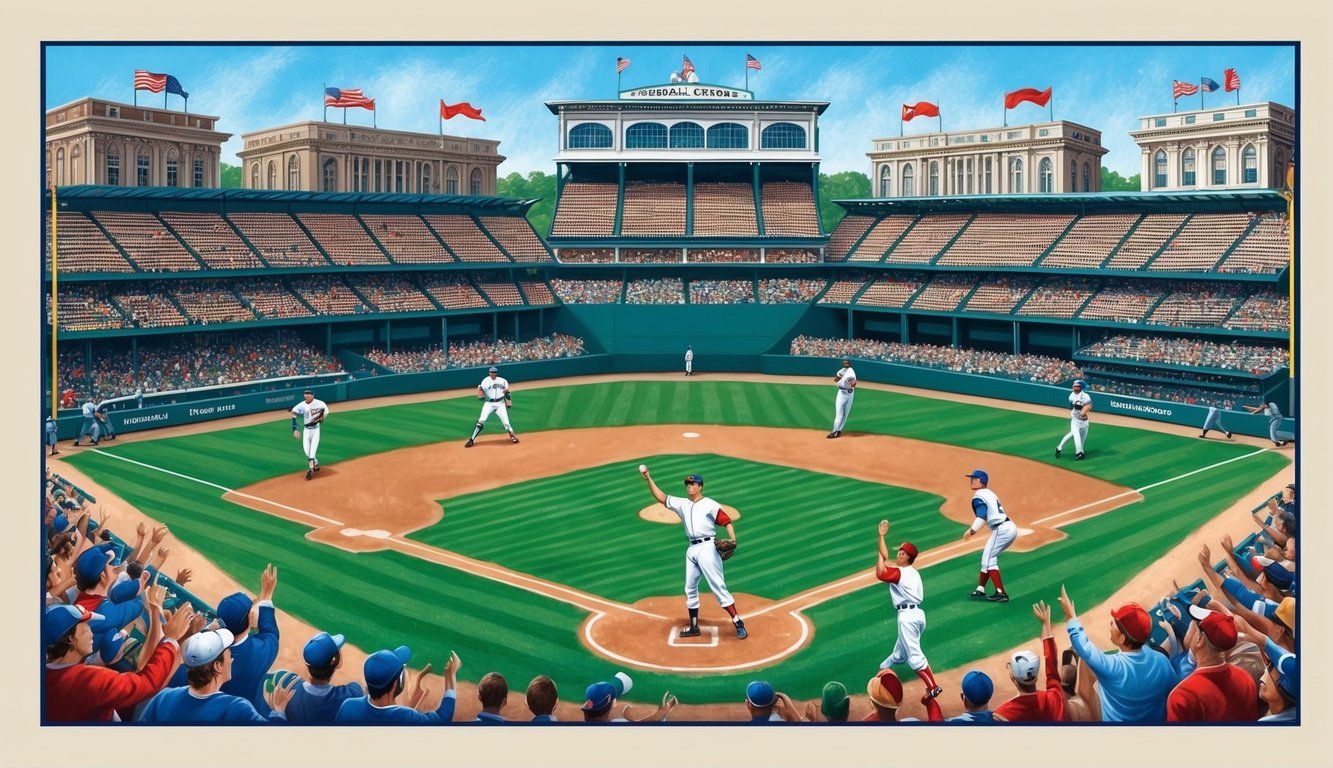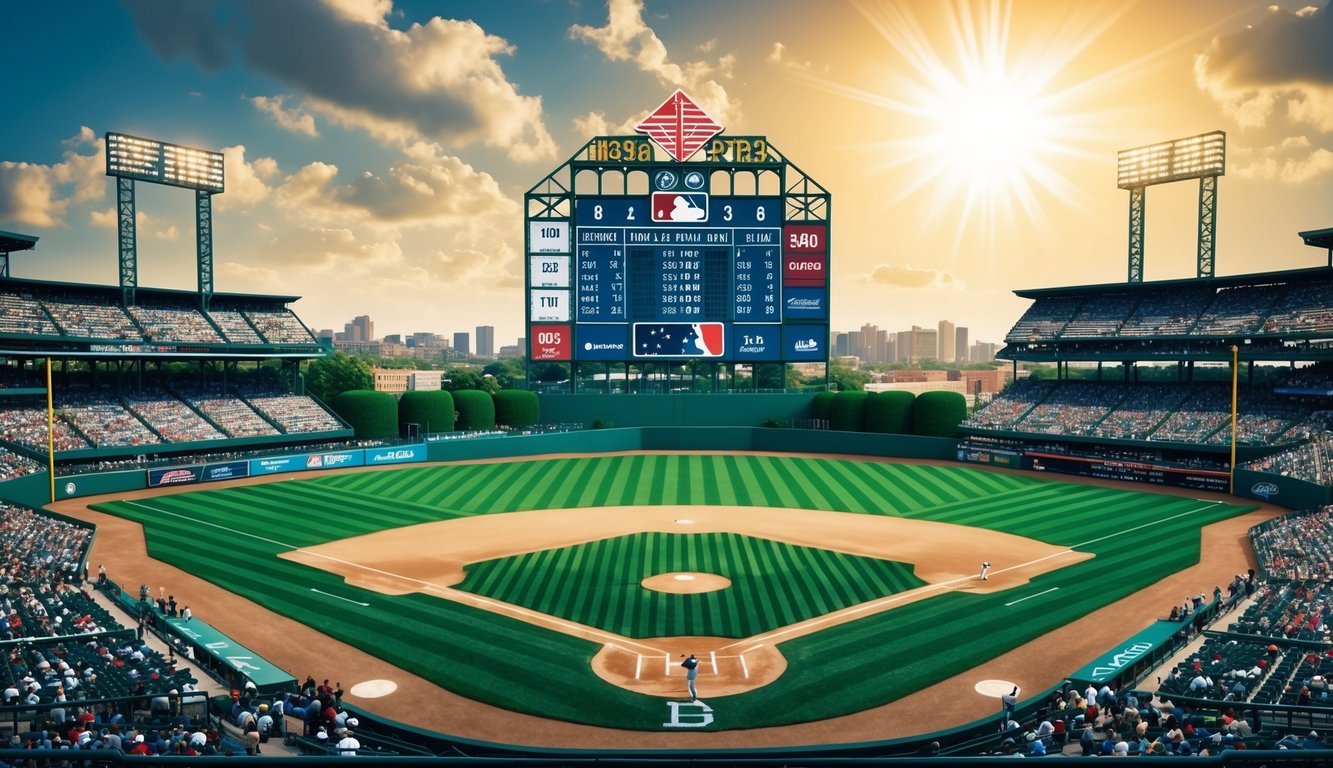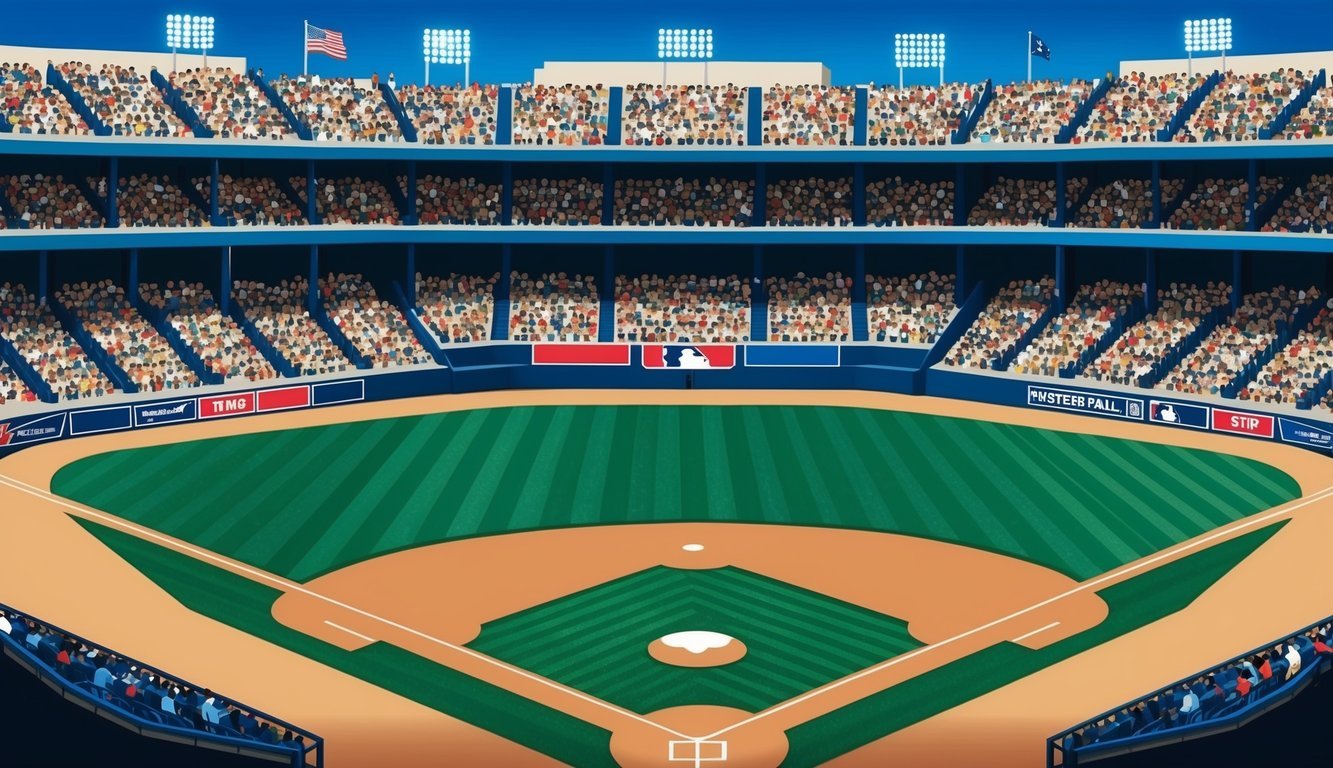Baseball has captivated fans for generations with its thrilling moments that have become etched in history.
From incredible plays on the field to groundbreaking achievements off it, the sport has produced countless memories that resonate deeply with American culture.
The sport’s rich tapestry includes legendary feats like Babe Ruth’s called shot and Jackie Robinson breaking the color barrier.
Such events transcend the game itself, reflecting broader societal changes and inspiring generations of players and fans alike.
Whether it’s a perfect game, a record-breaking home run, or a miraculous comeback, baseball’s most iconic moments continue to be celebrated and remembered.
These historic moments have not only shaped baseball but have also helped cement its status as the national pastime of the United States.
The sport’s historic snapshots offer more than just excitement for fans.
They provide valuable insights into the evolution of the sport, showcasing how rules, strategies, and player abilities have changed over time.
By examining these pivotal moments, enthusiasts can gain a deeper appreciation for baseball’s enduring impact on American culture and its ability to bring people together through shared experiences.
The Origins and Evolution of Baseball

Baseball’s journey from informal pastime to global phenomenon is a fascinating tale of innovation, cultural impact, and athletic achievement.
The sport’s development reflects America’s own growth and changing values over nearly two centuries.
As baseball evolved, it not only became a source of entertainment but also a unifying force that transcended social and economic barriers.
Generations of players and fans have shared in the experience, learning not just how to play baseball, but also the values of teamwork, perseverance, and sportsmanship along the way.
Today, its influence is felt worldwide, bringing people together across cultures while retaining its quintessentially American roots.
From Pastime to Professional Sport
Baseball’s roots trace back to English bat-and-ball games like rounders and cricket.
In the mid-1800s, these games evolved into a uniquely American sport.
The Knickerbocker Base Ball Club, founded in New York in 1845, played a crucial role in shaping modern baseball.
Alexander Cartwright, a Knickerbocker member, codified many of the game’s essential rules.
These included the diamond-shaped infield and the concept of “foul territory.” The first recorded baseball game took place in 1846 in Hoboken, New Jersey.
As baseball’s popularity grew, the first professional team emerged in 1869 – the Cincinnati Red Stockings.
This paved the way for the formation of the National League in 1876, marking the beginning of Major League Baseball as we know it today.
Innovation and Rule Changes
Baseball’s rules have undergone numerous changes since its inception.
Early games often saw scores in the 20s or 30s, prompting adjustments to create a more balanced contest between offense and defense.
Key innovations included:
- The introduction of the pitcher’s mound (1880s)
- Standardization of the ball’s size and weight (1872)
- Implementation of the foul strike rule (1901)
- Addition of the designated hitter in the American League (1973)
These changes shaped the strategic elements of the game, influencing pitching techniques, batting styles, and defensive positioning.
The evolution of equipment, from gloves to bats, also played a significant role in baseball’s development.
The Global Spread: Baseball Around the World
While baseball is often called “America’s Pastime,” it has gained immense popularity worldwide.
Japan embraced the sport in the late 19th century, leading to the formation of the Nippon Professional Baseball league in 1936.
Latin American countries, particularly Cuba, the Dominican Republic, and Venezuela, have become baseball powerhouses.
These nations have produced numerous MLB stars and developed their own vibrant baseball cultures.
The inclusion of baseball in the Olympics (from 1992 to 2008, and again in 2021) further boosted its global profile.
Today, professional leagues exist in countries like South Korea, Australia, and Italy, showcasing baseball’s international appeal.
Media and Books: Chronicling Baseball History
Baseball’s rich history has been extensively documented through various media.
Early newspaper coverage helped popularize the sport, while radio broadcasts in the 1920s brought games to a wider audience.
Television transformed baseball viewership, with the first televised game airing in 1939.
Today, streaming services and social media platforms continue to shape how fans engage with the sport.
Numerous books have captured baseball’s essence:
- “Baseball: A History of America’s Game” by Benjamin G. Rader
- “The Glory of Their Times” by Lawrence S. Ritter
- “Moneyball” by Michael Lewis
These works, along with countless others, have helped preserve baseball’s legacy, bringing its stories and statistics to life for generations of fans.
Iconic Moments and Legendary Figures
Baseball’s rich history is filled with unforgettable plays and larger-than-life personalities that have captivated fans for generations.
These iconic moments and legendary figures have shaped the sport’s enduring legacy.
Babe Ruth: The Sultan of Swat
Babe Ruth revolutionized baseball with his prodigious power hitting.
His 714 career home runs stood as the all-time record for decades.
Ruth’s larger-than-life personality and on-field exploits made him baseball’s first true superstar.
The Bambino’s called shot in the 1932 World Series remains one of the game’s most legendary moments.
Ruth allegedly pointed to the centerfield bleachers before hitting a home run to that exact spot.
Ruth’s impact extended beyond statistics.
He transformed baseball from a low-scoring affair into a power-hitting spectacle that thrilled fans.
His popularity helped baseball recover from the 1919 Black Sox scandal.
Breaking Barriers: Jackie Robinson’s Legacy
Jackie Robinson broke baseball’s color barrier in 1947, becoming the first African American to play in the major leagues.
His courageous actions paved the way for integration in baseball and American society.
Robinson faced intense racism and hostility with dignity and restraint.
His stellar play earned him Rookie of the Year honors and helped the Brooklyn Dodgers win the National League pennant.
Robinson’s number 42 is retired across all MLB teams.
His legacy is celebrated each April 15th, when all players wear 42 to honor his groundbreaking achievements.
The Magic of Home Runs
Home runs have provided some of baseball’s most magical moments.
Hank Aaron’s 715th homer in 1974 broke Babe Ruth’s all-time record.
The moment was celebrated as a triumph over racism and a crowning achievement for one of the game’s greatest players.
Barry Bonds later surpassed Aaron’s mark, finishing with 762 career home runs.
While controversial due to steroid allegations, Bonds’ incredible power and plate discipline amazed fans.
Other iconic blasts include Bobby Thomson’s “Shot Heard ‘Round the World” in 1951 and Joe Carter’s World Series-winning walk-off in 1993.
Invaluable Contributions and Careers
Many legends made invaluable contributions beyond home runs.
Lou Gehrig’s 2,130 consecutive games played stood for 56 years until Cal Ripken Jr. broke it in 1995.
Gehrig’s “Luckiest Man” speech remains one of sports’ most poignant moments.
Ted Williams was the last player to hit .400 in a season, achieving the feat in 1941.
His dedication to the science of hitting influenced generations of players.
Derek Jeter embodied excellence and winning during his 20-year career with the New York Yankees.
His “flip play” in the 2001 playoffs is considered one of the greatest defensive plays in history.
Historic Championships and World Series Milestones
The World Series has given baseball fans countless unforgettable moments, legendary performances, and dramatic finishes that have shaped the sport’s rich history.
From epic rivalries to clutch home runs, these championships have created lasting memories.
Epic Battles and Rivalries
The New York Yankees and Boston Red Sox rivalry has produced some of baseball’s most intense World Series matchups.
Their 2004 clash saw the Red Sox overcome a 3-0 series deficit, a first in MLB history.
This victory ended Boston’s 86-year “Curse of the Bambino.”
The St. Louis Cardinals and Philadelphia Phillies have also had memorable World Series encounters.
Their 2011 series went to seven games, with the Cardinals emerging victorious in a nail-biting finale.
Crosstown rivalries have added extra spice to the Fall Classic.
The 1906 “Hitless Wonders” Chicago White Sox upset the heavily favored Chicago Cubs, setting the tone for future intracity showdowns.
Unforgettable World Series Games
Game 6 of the 1975 World Series stands out for Carlton Fisk’s iconic home run.
His 12th-inning blast off the foul pole gave the Red Sox a dramatic win over the Cincinnati Reds.
Bill Mazeroski’s walk-off homer in Game 7 of the 1960 World Series remains one of baseball’s most thrilling moments.
His shot lifted the Pittsburgh Pirates over the Yankees in stunning fashion.
The 1988 World Series opener saw a hobbled Kirk Gibson hit an improbable pinch-hit home run.
His fist-pumping trot around the bases became an enduring image of Los Angeles Dodgers lore.
Postseason Heroes: Mr. October and Others
Reggie Jackson earned the nickname “Mr. October” for his clutch World Series performances.
His three home runs on three pitches in Game 6 of the 1977 World Series cemented his legendary status.
Joe Carter’s series-ending home run in 1993 gave the Toronto Blue Jays back-to-back titles.
His jubilant leap around the bases is etched in World Series history.
Madison Bumgarner’s dominant pitching in the 2014 World Series showcased a different kind of postseason heroics.
His five-inning save in Game 7 on two days’ rest led the San Francisco Giants to victory.
Ballparks: The Hallowed Grounds of History

Baseball stadiums are more than just venues; they’re living museums where history unfolds with each pitch.
These legendary parks have witnessed countless unforgettable moments, shaping the sport’s rich tapestry.
Cathedrals of the Game
Baseball stadiums stand as architectural marvels, blending form and function.
Their unique designs reflect the eras in which they were built, from classic brick facades to modern marvels of engineering.
Some parks boast quirky features that add character and challenge.
The Green Monster at Fenway Park and the ivy-covered walls of Wrigley Field are prime examples.
These ballparks have become integral parts of their communities.
They serve as gathering places for fans and symbols of civic pride.
Many stadiums incorporate local flavors in their concessions, offering regional specialties alongside traditional ballpark fare.
Fenway Park: A Beacon of History
Fenway Park, opened in 1912, is a testament to baseball’s enduring appeal.
Its manual scoreboard and intimate seating bring fans close to the action.
The park’s dimensions create unique playing conditions.
The short right field and deep center field have influenced game strategies for generations.
Fenway has hosted numerous historic events beyond baseball.
Concerts, political rallies, and even wedding ceremonies have taken place on its hallowed grounds.
The park’s renovation efforts have balanced modernization with preservation, ensuring its legacy continues for future generations of fans.
Iconic Plays and Stadium Lore
Each ballpark has its share of legendary moments etched in fans’ memories.
Carlton Fisk’s iconic home run off the foul pole at Fenway in the 1975 World Series stands out.
Wrigley Field’s basket catches, like those made by Cubs outfielders, have become part of baseball folklore.
Stadiums often feature tributes to great plays and players.
Statues, plaques, and retired numbers honor the legends who graced these fields.
Some parks have unique traditions, like the singing of “Take Me Out to the Ball Game” during the seventh-inning stretch at Wrigley Field.
Social Change and Baseball’s Influence

Baseball has played a pivotal role in shaping American society, reflecting broader cultural shifts and catalyzing social progress.
The sport’s history intertwines with civil rights, integration, and the power of individual athletes to inspire change.
Baseball as a Reflection of Society
Throughout its early years, baseball mirrored societal attitudes and prejudices.
Segregation in the sport echoed racial divides across America.
As social movements gained momentum, baseball became a battleground for equality.
The Brooklyn Dodgers took a bold step in 1947.
They signed Jackie Robinson, breaking the color barrier in Major League Baseball.
This move sent ripples far beyond the diamond.
Robinson’s presence challenged racist norms.
His success on the field proved talent knows no color.
Fans witnessed firsthand the absurdity of segregation.
The Legacy of the Negro Leagues
The Negro Leagues showcased exceptional talent excluded from the majors.
Stars like Satchel Paige and Josh Gibson became legends.
These leagues preserved and advanced baseball during segregation.
Negro League players displayed incredible skill and determination.
They faced harsh conditions and discrimination.
Yet they persevered, keeping their love for the game alive.
The integration of MLB led to the decline of Negro Leagues.
However, their impact endures.
The Negro Leagues Baseball Museum now honors this crucial chapter in baseball history.
Ballplayers Who Changed the World
Certain players transcended the sport, becoming symbols of progress.
Jackie Robinson’s courage paved the way for others.
His success inspired hope and challenged racial stereotypes.
Roberto Clemente championed humanitarian causes.
He used his platform to help others and tragically lost his life during a relief mission.
Curt Flood fought for players’ rights by challenging the reserve clause.
More recently, players like Carlos Delgado have protested war.
Others have supported LGBTQ+ rights and gender equality.
These athletes prove baseball’s power to spark conversations and drive social change.
